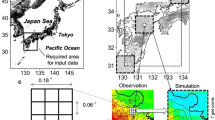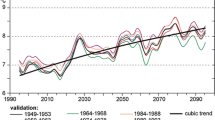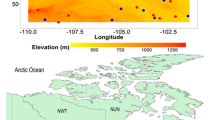Abstract
There are a number of sources of uncertainty in regional climate change scenarios. When statistical downscaling is used to obtain regional climate change scenarios, the uncertainty may originate from the uncertainties in the global climate models used, the skill of the statistical model, and the forcing scenarios applied to the global climate model. The uncertainty associated with global climate models can be evaluated by examining the differences in the predictors and in the downscaled climate change scenarios based on a set of different global climate models. When standardized global climate model simulations such as the second phase of the Coupled Model Intercomparison Project (CMIP2) are used, the difference in the downscaled variables mainly reflects differences in the climate models and the natural variability in the simulated climates. It is proposed that the spread of the estimates can be taken as a measure of the uncertainty associated with global climate models. The proposed method is applied to the estimation of global-climate-model-related uncertainty in regional precipitation change scenarios in Sweden. Results from statistical downscaling based on 17 global climate models show that there is an overall increase in annual precipitation all over Sweden although a considerable spread of the changes in the precipitation exists. The general increase can be attributed to the increased large-scale precipitation and the enhanced westerly wind. The estimated uncertainty is nearly independent of region. However, there is a seasonal dependence. The estimates for winter show the highest level of confidence, while the estimates for summer show the least.
Similar content being viewed by others
References
Barthelet, P., L. Terray, and S. Valcke, 1998: Transient CO2 experiment using the ARPEGE/OPAICE non flux corrected coupled model. Geophys. Res. Lett., 25, 2277–2280.
Benestad, R. E., 2001: A comparison between two empirical downscaling strategies. International Journal of Climatology, 21, 1645–1668.
Benestad, R. E., 2002: Empirically downscaled multimodel ensemble temperature and precipitation scenarios for Norway. J. Climate, 15, 3008–3027.
Blenckner, T., and D. Chen, 2003: Comparison of the impact of regional and North Atlantic atmospheric circulation on an aquatic ecosystem. Climate Research, 23, 131–136.
Boville, B. A., and P. R. Gent, 1998: The NCAR Climate System Model, Version One. J. Climate, 11, 1115–1130.
Braconnot, P., O. Marti, and S. Joussaume, 1997: Adjustment and feedbacks in a global coupled ocean-atmosphere model. Climate Dyn., 13, 507–519.
Busuioc, A., D. Chen, and C. Hellström, 2001a: Performance of statistical downscaling models in GCM validation and regional climate change estimates: Application for Swedish precipitation. International Journal of Climatology, 21, 557–578.
Busioc, A., D. Chen, and C. Hellström, 2001b: Temporal and spatial variability of precipitation in Sweden and its link with the large scale atmospheric circulation. Tellus, 53A, 348–367.
Chen, D., and C. Hellström, 1999: The influence of the North Atlantic Oscillation on the regional temperature variability in Sweden: Spatial and temporal variations. Tellus, 51A, 505–516.
Chen, D., 2000: A monthly circulation climatology for Sweden and its application to a winter temperature case study. International Journal of Climatology, 20, 1067–1076.
Chen, D., and X. Li, 2004: Scale dependent relationship between maximum ice extent in the Baltic Sea and atmospheric circulation. Global and Planetary Change, 41, 275–283.
Christensen, J.-H., J. Räisänen, T. Iversen, D. Bjørge, O. B. Christensen, and M. Rummukainen, 2001: A synthesis of regional climate change simulations. A Scandinavian perspective. Geophys. Res. Lett., 28, 1003–1006.
Emori, S., T. Nozawa, A. Abe-Ouchi, A. Numaguti, M. Kimoto, and T. Nakajima, 1999: Coupled ocean-atmosphere model experiments of future climate change with an explicit representation of sulfate aerosol scattering. J. Meteor. Soc. Japan, 77, 1299–1307.
Fan, L., C. Fu, and D. Chen, 2005: A survey on statistical downscaling in climate studies. Advance in Earth Sciences, 20(3), 320–329. (in Chinese)
Flato, G. M., G. J. Boer, W. G. Lee, N. A. McFarlane, D. Ramsden, M. C. Reader, and A. J. Weaver, 2000: The Canadian Centre for Climate Modelling and Analysis Global Coupled Model and its climate. Climate Dyn., 16, 451–467.
Frich, F., and Coauthors, 1996: North Atlantic Climatological Dataset (NACD Version 1)-Final Report. DMI Report, Copenhagen, Denmark, 47pp.
Giorgi, F., and R. Francisco, 2000: Evaluating uncertainties in the prediction of regional climate change. Geophys. Res. Lett., 27, 1295–1298.
Gordon, C., C. Cooper, C. A. Senior, H. Banks, J. M. Gregory, T. C. Johns, J. F. B. Mitchell, and R. A. Wood, 2000: The simulation of SST, sea ice extents and ocean heat transports in a version of the Hadley Centre Coupled Model without flux adjustments. Climate Dyn., 16, 147–168.
Hanssen-Bauer, I., C. Achberger, R. Benestad, D. Chen, and E. Førland, 2005: Empirical-statistical downscaling of climate scenarios over Scandinavia: A review. Climate Research, 29, 255–268.
Hellström, C., and D. Chen, 2003: Statistical downscaling based on dynamically downscaled predictors: Application to monthly precipitation in Sweden. Adv. Atmos. Sci., 20, 951–958.
Hellström, C., D. Chen, C. Achberger, and J. Räisänen, 2001: A comparison of climate change scenarios for Sweden based on statistical and dynamical downscaling of monthly precipitation. Climate Research, 19, 45–55.
Hewitson, B. C., and R. C. Grane, 1996: Climate downscaling: Techniques and application. Climate Research, 7(2), 85–95.
Hirst, A., S. P. O’Farrell, and H. B. Gordon, 2000: Comparison of a coupled ocean-atmosphere model with and without oceanic eddy-induced advection. Part I: Ocean spinup and control integrations. J. Climate, 13, 139–163.
Johansson, B., and D. Chen, 2003: The influence of wind and topography on precipitation distribution. A case study in Sweden. Internation Journal of Climatology, 23, 1523–1535.
Johns, T. C., R. E. Carnell, J. F. Crossley, J. M. Gregory, J. F. B. Mitchell, C. A. Senior, S. F. B. Tett, and R. A. Wood, 1997: The second Hadley Centre Coupled ocean-atmosphere GCM: Model description, spinup and validation. Climate Dyn., 13, 103–134.
Katz R. W., 2002: Techniques for estimating uncertainty in climate change scenarios and impact studies. Climate Research, 20, 167–185.
Linderson, M.-L., C. Achberger, and D. Chen, 2004: Statistical downscaling and scenario construction of precipitation in Scania, southern Sweden. Nordic Hydrology, 35, 261–278.
Manabe, S., R. J. Stouffer, M. J. Spelman, and K. Bryan, 1991: Transient responses of a coupled ocean-atmosphere model to gradual changes of atmospheric CO2, Part I: Annual mean response. J. Climate, 4, 785–818.
Meehl, G. A., G. J. Boer, C. Covey, M. Latif, and R. J. Stouffer, 2000: The Coupled Model Intercomparison Project (CMIP). Bull. Amer. Meteor. Soc., 81, 313–318.
Murphy, J., 2000: Predictions of climate change over Europe using statistical and dynamical downscaling techniques. Internation Journal of Climatology, 20, 489–501.
Omstedt, A., and D. Chen, 2001: Influence of atmospheric circulation on the maximum ice extent in the Baltic Sea. J. Geophys. Res., 106, 4493–4500.
Power, S. B., R. A. Colman, B. J. McAvaney, R. R. Dahni, A. M. Moore, and N. R. Smith, 1993: The BMRC coupled atmosphere/ocean/sea-ice model. BMRC Research Report No. 37, Bureau of Meteorology Research Centre, Melbourne, Australia, 58pp.
Roeckner, E., L. Bengtsson, J. Feichter, J. Lelieveld, and H. Rodhe, 1999: Transient climate change simulations with a coupled atmosphere-ocean GCM including the tropospheric sulfur cycle. J. Climate, 12, 3004–3032.
Russell, G. L., and D. Rind, 1999: Response to CO2 transient increase in the GISS coupled model: Regional coolings in a warmer climate. J. Climate, 12, 531–539.
Tokioka, T., A. Noda, A. Kitoh, Y. Nikaidou, S. Nakagawa, T. Motoi, S. Yukimoto, and K. Takata, 1995: A transient CO2 experiment with the MRI CGCM. Quick Report. J. Meteor. Soc. Japan, 73, 817–826.
Voss, R., R. Sausen, and U. Cubasch, 1998: Peridiocally synchronously coupled integrations with the atmosphere-ocean general circulation model ECHAM3/LSG. Climate Dyn., 14, 249–266.
Washington, W. M., and G. A. Meehl, 1996: High-latitude climate change in a global coupled ocean-atmosphere-sea ice model with increased atmospheric CO2. J. Geophys. Res., 101, 12795–12801.
Washington, W. M., and Coauthors, 2000: Parallel climate model (PCM) control and transient simulations. Climate Dyn., 16, 755–774.
Zhang Xuehong, Shi Guangyu, Liu Hui, and Yu Yongqiang, 2000: IAP Global Ocean-Atmosphere-Land System Model. Science Press, Beijing, 252pp.
Author information
Authors and Affiliations
Rights and permissions
About this article
Cite this article
Chen, D., Achberger, C., Räisänen, J. et al. Using statistical downscaling to quantify the GCM-related uncertainty in regional climate change scenarios: A case study of Swedish precipitation. Adv. Atmos. Sci. 23, 54–60 (2006). https://doi.org/10.1007/s00376-006-0006-5
Received:
Revised:
Issue Date:
DOI: https://doi.org/10.1007/s00376-006-0006-5




